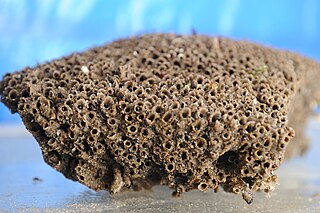
The Sipuncula or Sipunculida is a group containing about 162 species of bilaterally symmetrical, unsegmented marine worms. The name Sipuncula is from the genus name Sipunculus, and comes from the Latin siphunculus meaning a "small tube". Sipuncula seems to be closely related to Myzostomida, and Annelida.

The Polychaeta, also known as the bristle worms or polychaetes, are a paraphyletic class of annelid worms, generally marine. Each body segment has a pair of fleshy protrusions called parapodia that bear many bristles, called chaetae, which are made of chitin. More than 10,000 species are described in this class. Common representatives include the lugworm and the sandworm or clam worm Alitta.

The Terebellidae is a marine family of polychaete worms, of which the type taxon is Terebella, described by Carl Linnaeus in his 1767 12th edition of Systema Naturae.

Sabellidae, or feather duster worms, are a family of marine polychaete tube worms characterized by protruding feathery branchiae. Sabellids build tubes out of a tough, parchment-like exudate, strengthened with sand and bits of shell. Unlike the other sabellids, the genus Glomerula secretes a tube of calcium carbonate instead. Sabellidae can be found in subtidal habitats around the world. Their oldest fossils are known from the Early Jurassic.

Clinitrachus argentatus, the Cline, is a species of clinid found in shallow waters of the eastern Atlantic and the Mediterranean Sea. This species feeds primarily on benthic invertebrates. This species is currently the only known member of its genus.

Clinus acuminatus, the sad klipfish, is a species of fish in the family Clinidae. It is endemic to Southern Africa, where it occurs along the coast of Namibia and South Africa. It can reach a maximum length of 13 centimetres (5.1 in) TL and is viviparous. The sad klipfish feeds on crustaceans.

Sabellastarte spectabilis is a species of benthic marine polychaete worm in the Sabellidae family. It is commonly known as the feather duster worm, feather duster or fan worm. It is native to tropical waters of the Indo-Pacific but has spread to other parts of the world. It is popular in aquariums because of its distinctive appearance and its ability to remove organic particles and improve water quality.

Eupolymnia nebulosa is a species of sedentary marine polychaete worm in the Terebellidae family. It builds a tube of slime under stones or large shells on soft substrates on the lower shore and down to depths of about 500 metres.

Cirratulus cirratus is a species of marine polycheate worm in the family Cirratulidae. It occurs in the littoral and sub-littoral zones of the Atlantic Ocean.

Lanice conchilega, commonly known as the sand mason worm, is a species of burrowing marine polychaete worm. It builds a characteristic tube which projects from the seabed, consisting of cemented sand grains and shell fragments with a fringe at the top.

Lagis koreni, commonly known as the trumpet worm, is a species of marine polychaete worm found in European waters. It lives within a narrow conical tube made of grains of sand and shell fragments.

Sabellariidae is a family of marine polychaete worms in the suborder Sabellida. The worms live in tubes made of sand and are filter feeders and detritivores.

Eudistylia polymorpha, the giant feather duster worm, is a species of marine polychaete worm belonging to the family Sabellidae. Its common name is from the crown of tentacles extended when the animal is under water.

Serpula vermicularis, known by common names including the calcareous tubeworm, fan worm, plume worm or red tube worm, is a species of segmented marine polychaete worm in the family Serpulidae. It is the type species of the genus Serpula and was first described by Carl Linnaeus in his 1767 12th edition of Systema Naturae. It lives in a tube into which it can retract.

Sabella spallanzanii is a species of marine polychaete worms in the family Sabellidae. Common names include the Mediterranean fanworm, the feather duster worm, the European fan worm and the pencil worm. It is native to shallow waters in the northeastern Atlantic Ocean and the Mediterranean Sea. It has spread to various other parts of the world and is included on the Global Invasive Species Database.
Salmacina dysteri is a species of tube-forming annelid worm in the family Serpulidae. It is found on submerged rocks, reefs, piles and boats in many shallow and deeper water environments around the world.

Polydora ciliata is a species of annelid worm in the family Spionidae, commonly known as a bristleworm. It is a burrowing worm and is found in the northeastern Atlantic Ocean and some other parts of the world.
Arctonoe vittata is a species of scaled polychaete worms commonly known as a "scale worm". This species often lives as a commensal of another marine animal.

Poecilochaetus serpens is a species of marine polychaete worm in the family Poecilochaetidae. It is a benthic worm that burrows into soft sediment.

Spirobranchus cariniferus, commonly known as the blue tubeworm or spiny tubeworm, or by its Māori name toke pā, is a species of tube-building polychaete worm endemic to New Zealand.


















